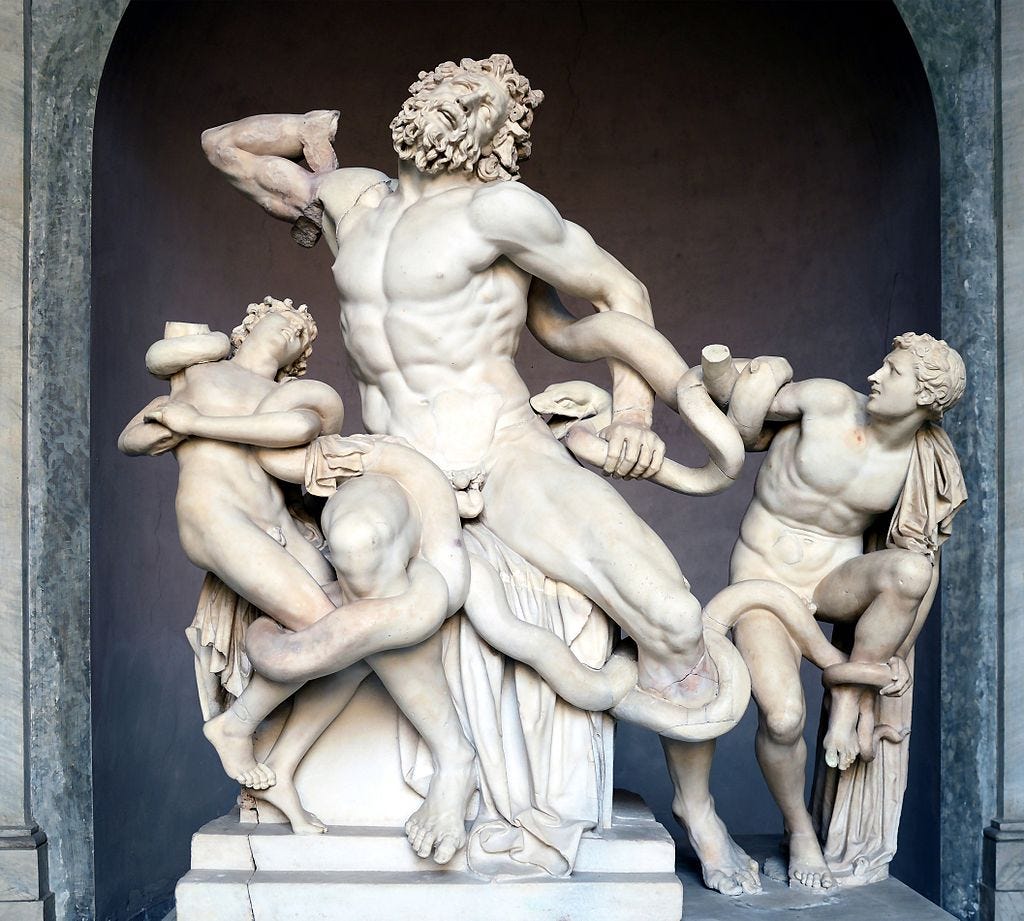Inspired by the writings of Homer and Virgil admired by Pope Julius II Michelangelo Raphael Titian Caravaggio Rubens Francis I and even Napoleon Laocoön and His Sons is truly a timeless masterpiece. Laocoon was the protagonist in a play by Sophocles that is now lost.

Laocoon The Work Of A Lifetime
The German art historian Johann Joachim Winckelmann 1717-68 saw the statue as the embodiment of Neoclassical nobility and heroicism although he admitted the inherent difficulty - for any observer of Laocoon - of appreciating beauty in a scene of death.

. The Laocoön group a famous sculpture of the Trojan priest and his two sons struggling with a huge serpent probably made by Rhodian artists in the 1st century ce but derived from examples of suffering figures carved in the 1st century bce is a good example Read More. El Greco completed the Laocoon towards the end of the Mannerist period which was exemplified by elongated and twisted figures artificiality the supernatural and the bizarre. Regardless if this is the case that bronze is lost to us probably melted down for weapons in a time of war so this Vatican Laocoon is now the original.
A naturalistic pose in sculpture in which the upper and lower parts of the body twist in different directionsContrapposto. Millennia before its time the sculpture foretells the modernist ambition of Cubist artists to capture contradictory emotions in a single compound countenance. The Laocoön group is one of the most discussed and famous pieces of Hellenistic sculpture described by Michaelangelo as a miracle of art.
This sculpture was carved into the side of a mountain. 123 experts online. Pliny the Elder a famous Roman author states that.
One work of art in particular has influenced some of the greatest artistic minds in history. Describe this sculpture its location and its purpose. It was distinctly Greco-Roman in style with the earliest figures had the head of Apollo with the body dressed in a Roman-style toga.
The following best describes the sculpture laocoon and his sons. The statue is of three figures the Laocoon and his two sons who are tangled. Laocoön and His Sons is a marble sculpture from the Hellenistic Period 323 BCE 31 CE.
The Hellenistic baroque style of Laocoon and His Sons gives us a much more true-to-life representation in comparison to earlier works. This incredible 18th-century Laocoön and His Sons is one of only a. As a Classical Realist You are ethical and self-assured.
The statue of Laocoön and His Sons also called the Laocoön Group Italian. The carvers of the statue are attributed to three artists who lived in the island of Rhodes. However Winckelmanns descriptions of.
It is very likely the same statue that was praised in the highest terms by the main Roman writer on art. This work has inspired artists and regular humans alike down through the centuries one of whom it is particularly well known to have influenced greatly was Michelangelo. Its expression of pain has received praise for centuries from the time of the Roman author Pliny the Elder all the way to the modern period.
As can be seen in some of his pieces. The sculpture is believed to be made around 42 to 20 BC. The use of contrasts of light and dark in a painting to give the impression of volumeChiaroscuro.
It is known as Laocoön and his sons or. Following its discovery in a Roman vineyard in 1506 it was placed in the Vatican where it remains today. In the 18th century the statue found a special place in the writings of the German classicist Johann Joachim Winckelmann.
In true Hellenistic fashion Laocoön and His Sons showcases an interest in the realistic depiction of movement. Inspiration for Winckelmann. Mannerism followed on the heels of and was in some ways a reaction against the Renaissance and its penchant for classicism and naturalism.
In this case the freely spaced figures of the statue ideally portrays the nature of the artists emotions and free flowing passion of exploring themes on. Original sculpture Esquiline Hill Rome c. The sculpture that depicts this startling event a sculpture that now sits in the Vatican Museums in Rome is surely one of the great works of Western art.
The statue of Laocoön and His Sons can be presently found in Vatican Museum in Rome. The Laocoon is a Hellenistic sculpture from either the third or second century BC and it depicts the demise of the Trojan priest and his two sons. It may have been a marble copy of a bronze original from the Greek kingdom of Pergamum as it is in Pergamene style circa 140 BC two hundred years previously.
Agesander Athenodoros and Polydorus. The dramatic use of intensely dark backgrounds and bright light to heighten the impact of a paintingTenebrism. Gruppo del Laocoonte has been one of the most famous ancient sculptures ever since it was excavated in Rome in 1506 and placed on public display in the Vatican Museums where it remains.
Laocoon and his sons is one of antiquitys most famous sculptures. He was also written about by Virgil. Laocoon and His Sons is a marble sculpture representing a scene that is a part of the tale of the siege and invasion of Troy.
The statue is made in Hellenistic style which depicts the emotional nature of the artist. 5020 BC Cast from marble original Height 238 cm Acquired from the British Museum 1933 View on our online Collection Online Site.

Laocoon And His Sons Ancient Greek Art As A Model For Cultural Identity The Thinker

Great Works Of Art The Laocoon The Story Goes Like This Helen Was The By Christopher P Jones Thinksheet Medium

A Masterpiece For The Ages Laocoon And His Sons Beauty Rarity History The M S Rau Blog Blog From Artfixdaily Com

0 Comments